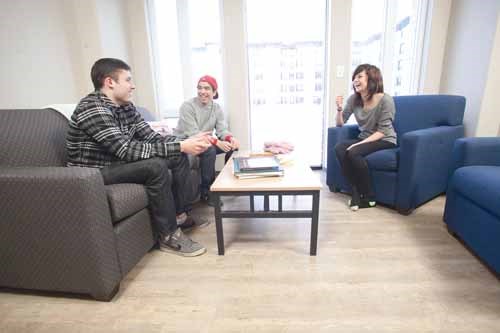Discovery is a fundamental part of education at the University of Saskatchewan, and students play an integral part by applying fresh perspectives to existing knowledge.
Students are encouraged to embrace discovery early. One opportunity allows undergraduate students to spend their summers conducting research in disciplines ranging from physics and psychology to biology and mathematics and statistics. Students work in research labs under the supervision of U of S faculty and their findings are presented at a juried poster competition.
Some of the student research now has a more permanent home, thanks to a new online U of S journal launched in 2013.
The USURJ (U of S Undergraduate Research Journal) was created and is run by undergrads in association with the University Learning Centre (ULC). The biannual faculty-reviewed journal issued its first call for submissions in the fall of 2013 and is planning its first issue in February 2014.
"We're hoping it will make undergraduate research more visible on campus," said medical student Scott Adams, who shares editor-in-chief duties with graduate student Danielle Bruni-Bossio. "Our aim is to encourage students to take advantage of (research) opportunities, and to create a supportive environment for undergraduate research."
Adams explained that USURJ's genesis came in January 2012 when the undergraduate community first formally proposed the concept of a dedicated research journal. Funding from the U of S Office of the Vice President Research and the ULC supported the hiring of Bruni-Bossio on a graduate student fellowship and the building of a journal website at www.usask.ca/urj.
The USURJ is throwing its net wide to cover any research area.
"We are aiming for a balance among all disciplines," Adams said. "Submissions might include research from a summer project, undergraduate honours theses or something written for a class. It's meant to include original research not published elsewhere."
The journal is also meant to give undergraduate students a taste of what research offers, enticing them to pursue graduate studies and associated career options. While at first students will likely submit work they have already done, it is hoped they will start to write with publication in mind as the journal gains prominence.
"The undergraduate researchers are our future graduate students, researchers and innovators in their own right," said Adams. "If we can encourage them now to engage in research, it'll support us in our goal of bringing them into graduate studies and immersing them in the research culture of the university."
For many new U of S students going to university doesn't only mean starting a new program of study, it also means finding a new place to live. More than 1,300 students live in the two largest residence complexes at the U of S, Voyageur Place and College Quarter, and each building offers its own distinct atmosphere and student experience.
One aspect students may wish to consider when choosing a residence is convenience, especially if this is the first time they will live away from home. Voyageur Place is a popular choice for first-year students because it is linked to most classroom and student service buildings by a tunnel system. This means that while other students arrive in class wearing snow boots and parkas, they can get to class in 10 minutes or less wearing pyjamas and flip-flops, if they choose.
In addition, because meals are prepared for Voyageur Place residents, they don't need to worry about buying groceries or doing the dishes, something Luran Lu, an international student from Shanghai, China, enjoys. "It's really helpful," he says. "You save lots of time that way, and you get to do more studying and hang out with friends more."
Residents of the College Quarter residence complex may have to brave the short walk in the cold to get to their classes, but these buildings are also a popular choice with students. Larissa Kurz, a student from Central Butte, Saskatchewan, chose to live in College Quarter because, she says, "it feels more like an apartment building than a university residence."
College Quarter is the newest residence for undergraduate students, offering fully furnished four-bedroom, two-bathroom suites with open concept living and eating areas, as well as several large, bright lounges which are popular hangouts for students. College Quarter residence assistants (RAs) work hard to provide opportunities for students to get together to study or socialize. "They've always got some kind of event organized," says Kurz.
No matter which residence students choose, each offers a comfortable, secure and convenient environment for students to live in. Both personal and academic support services are available to all residents, allowing them to devote more attention to their studies and to having fun. "The best part about residence is the people," Kurz emphasizes. "You meet so many new friends."


.png;w=120;h=80;mode=crop)

